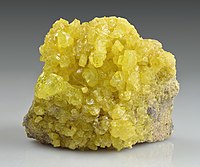
Photo from wikipedia
Summary Chemotrophic microorganisms gain energy for cellular functions by catalyzing oxidation–reduction (redox) reactions that are out of equilibrium. Calculations of the Gibbs energy (ΔGr) can identify whether a reaction is… Click to show full abstract
Summary Chemotrophic microorganisms gain energy for cellular functions by catalyzing oxidation–reduction (redox) reactions that are out of equilibrium. Calculations of the Gibbs energy (ΔGr) can identify whether a reaction is thermodynamically favourable and quantify the accompanying energy yield at the temperature, pressure and chemical composition in the system of interest. Based on carefully calculated values of ΔGr, we predict a novel microbial metabolism – sulfur comproportionation (3H2S + SO42− + 2H+ ⇌ 4S0 + 4H2O). We show that at elevated concentrations of sulfide and sulfate in acidic environments over a broad temperature range, this putative metabolism can be exergonic (ΔGr<0), yielding ~30–50 kJ mol−1. We suggest that this may be sufficient energy to support a chemolithotrophic metabolism currently missing from the literature. Other versions of this metabolism, comproportionation to thiosulfate (H2S + SO42− ⇌ S2O32− + H2O) and to sulfite (H2S + 3SO42− ⇌ 4SO32− + 2H+), are only moderately exergonic or endergonic even at ideal geochemical conditions. Natural and impacted environments, including sulfidic karst systems, shallow‐sea hydrothermal vents, sites of acid mine drainage, and acid–sulfate crater lakes, may be ideal hunting grounds for finding microbial sulfur comproportionators.
Journal Title: Environmental Microbiology
Year Published: 2020
Link to full text (if available)
Share on Social Media: Sign Up to like & get
recommendations!